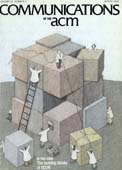March 1989 - Vol. 32 No. 3

Features
The 1988 snowbird report: a discipline matures
With the severe crisis in computing behind us, the field is beginning to shed its preoccupation with its internal affairs. The representation of computing research to the public and to policy makers, was a major issue at Snowbird 88. Since no single entity fills this role, the Computing Research Board plans to fill it.
Expert systems for configuration at Digital: XCON and beyond
Members of Digital Equipment Corporation's team of expert system experts reflect and recount a decade's worth of lessons learned in designing, and building a core of configuration systems
Methodology for allocating resources for data quality enhancement
The issue of effective use of resources committed to data integrity maintenance is addressed via a heuristic which uses parameter estimates that are iteratively refined to partition available resources among multiple data sets.
An entity-life modeling approach to the design of concurrent software
Using the idea of Entity-Life Modeling for task decomposition, the design of a prototypical elevator control system is explored and compared to an earlier JSD solution.
A practical sieve algorithm finding prime numbers
Based on the sieve of Eratosthenes, a faster and more compact algorithm is presented for finding all primes between 2 and N.
System structure and software maintenance performance
An experiment is designed to investigate the relationship between system structure and maintainability. An old, ill-structured system is improved in two sequential stages, yielding three system versions for the study. The primary objectives of the research are to determine how or whether the differences in the systems influence maintenance performance; whether the differences are discernible to programmers; and whether the differences are measurable. Experienced programmers perform a portfolio of maintenance tasks on the systems. Results indicate that system improvements lead to decreased total maintenance time and decreased frequency of ripple effect errors. This suggests that improving old systems may be worthwhile and may yield benefits over the remaining life of the system. System differences are not discernible to programmers; apparently programmers are unable to separate the complexity of the systems from the complexity of the maintenance tasks. This finding suggests a need for further research on the efficacy of subjectively based software metrics. Finally, results indicate that a selected set of automatable, objective complexity metrics reflected both the improvements in the system and programmer maintenance performance. These metrics appear to offer potential as project management tools.
Parallel thinning with two-subiteration algorithms
Two parallel thinning algorithms are presented and evaluated in this article. The two algorithms use two-subiteration approaches: (1) alternatively deleting north and east and then south and west boundary pixels and (2) alternately applying a thinning operator to one of two subfields. Image connectivities are proven to be preserved and the algorithms' speed and medial curve thinness are compared to other two-subiteration approaches and a fully parallel approach. Both approaches produce very thin medial curves and the second achieves the fastest overall parallel thinning.



